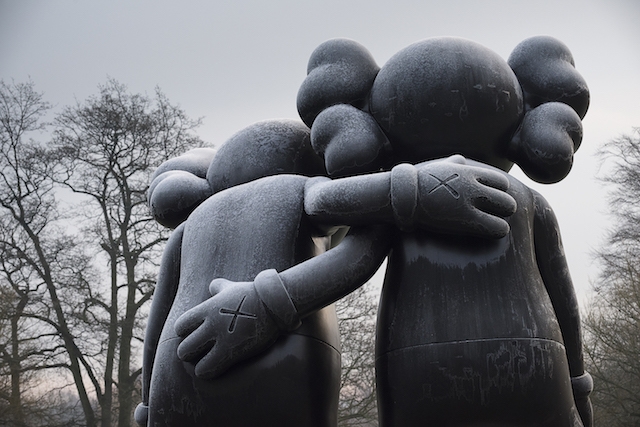After the tyrant Iskander is overthrown in Salman Rushdie’s 1983 novel Shame, his exiled wife weaves the history of his reign into 18 magnificent shawls. Rather than the glowing tributes to his greatness that the king might have expected from a dutiful consort, however, Rani’s fabrics relate in graphic detail the systematic torture, sexual violence and moral corruption through which her husband exercised power. Life came to imitate art when, after the publication of his ‘blasphemous’ next novel prompted Ayatollah Khomeini to issue a fatwa against him, Rushdie was also forced into hiding. The official histories of absolutist regimes are enforced, as neither the author nor his character needed to be told, by violence.

Wu Tsang at Martin-Gropius-Bau, Berlin, 4 September – 12 January
If everyone projects their own truth onto the world then, as the title of Wu Tsang’s exhibition at Berlin’s Gropius Bau proposes, ‘there is no nonviolent way to look at somebody’. This survey of the trans artist’s work, which includes a new video installation shot on the Greek island at the centre of the migrant crisis, extends the artist’s attempts to unsettle fixed categories (of gender, ethnicity, nationhood) by disrupting the conventions of documentary filmmaking. By interpreting the world through fluid and hybrid narrative strategies that recall Rushdie’s magical realism, Tsang’s work also suggests that, while looking is always fraught, some ways are more compassionate than others. The effect is to render the dissolution of real-world borders (whether of gender, nationality or any other reductive category) as, according to curator Stephanie Rosenthal, ‘a crisis of representation’.
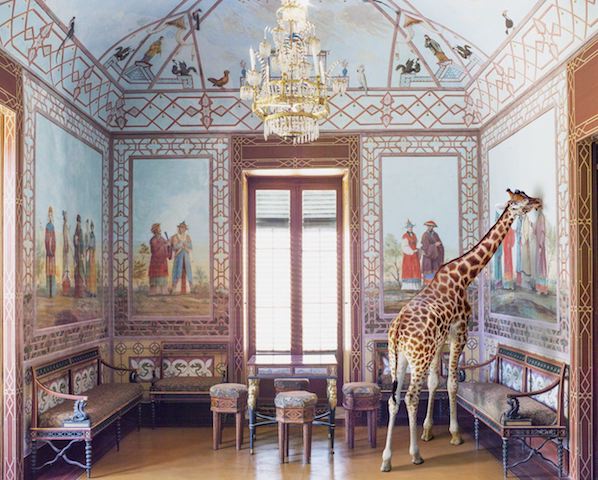
Karen Knorr at Sundaram Tagore, Singapore, 21 September–16 November
Such crises are the theme of Ovid’s Metamorphoses (c. 8CE), source of the legend of the weaver Arachne that Rushdie adapted to the subcontinent’s post-partition history. A similarly syncretic approach to Asian and European cultures informs the work of photographer Karen Knorr, who juxtaposes anthropological studies of the English upper class (Belgravia, 1979–81) with her celebrated series India Song (2008–2017) at Sundaram Tagore in Singapore. The photographs in a series titled, conveniently for the sake of this digest, Metamorphoses (2014–2018), transport conspicuously ‘exotic’ animals into opulent Italian palazzos, the free play of signifiers seeming to celebrate the movement of people and ideas across borders. Besides which, who doesn’t want to look at a photograph in which a giraffe appears to lick clean an Orientalist fresco.
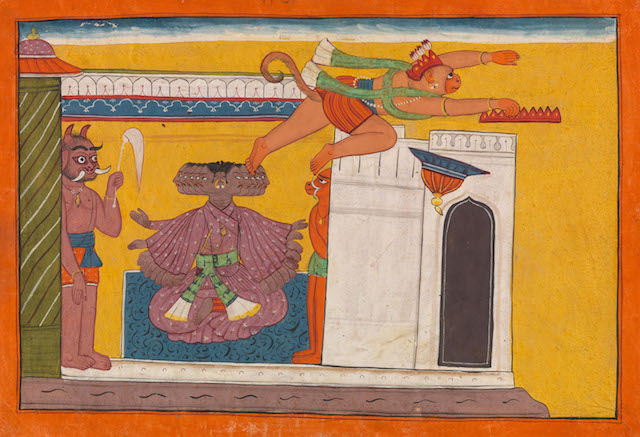
Sita and Rama: The Ramayana in Indian Painting at Metropolitan Museum of Art, New York, through 23 August 2020
New York’s Metropolitan Museum of Art has recently opened Sita and Rama: The Ramayana in Indian Painting, which displays work made between the seventeenth and nineteenth centuries inspired by the Sanskrit epic. The Ramayana offers another example, if it were needed, of how art can be used to support or disrupt the fixed and singular narratives that buttress the myth of fixed and singular identities: in 2011, a celebrated essay by A.K. Ramanujan was removed from the syllabus of Delhi University after protests that its celebration of the poem’s hundreds of different versions was offensive to ultra-orthodox Hindus. For a less prescriptive reading of the world’s cultures, meet Chopra in The Temple of Dendur (floor 1, gallery 131).
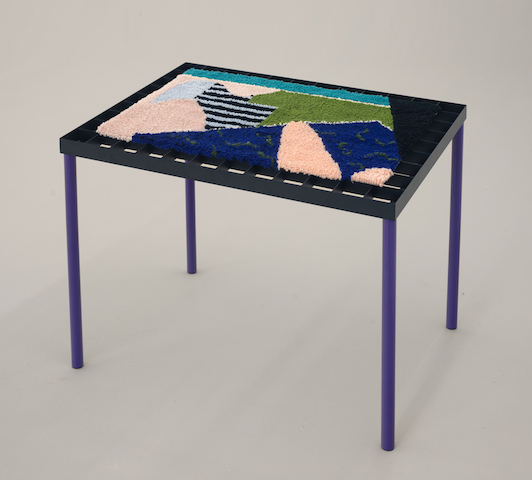
A distant relative at Hopkinson Mossman, Wellington, through 28 September
After Arachne had the temerity to express her own experience of reality (in which the gods abuse their power over humans) and defeat her divine rival in a test of skill, Minerva beat her over the head with a shovel (rather proving her point). Which might serve as a warning to Ruth Buchanan, Oliver Perkins, Peter Robinson and Renee So, whose disparate practices are threaded together at Wellington’s Hopkinson Mossman by their shared inheritance of Arachne’s… umm… thread. With a title that nods to the looseness of the ties that bind these artists together, A distant relative features ‘knitted tapestries, paintings tied up with braided rope, hand-latch hooked rugs, and drooping felt’. A craft always associated with the structuring of subaltern narratives offers a means by which artists can, it is proposed, ‘position themselves in relation to a total(ising) structure’ of power. Arachne, it seems fair to presume, would sympathise.
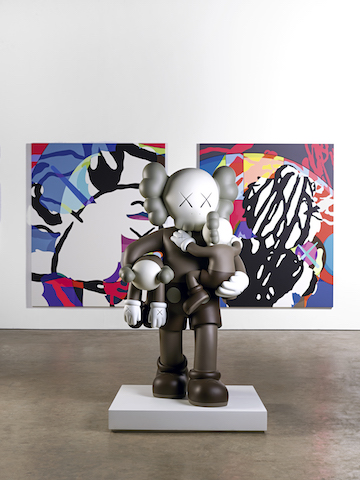
KAWS at National Gallery of Victoria, Melbourne, through 13 April 2020
New York-based KAWS first came to prominence as a street artist making interventions on billboard posters in his hometown, a practice he labelled ‘subvertising’. While he may share our heroine’s desire to undermine the stories told by the hegemonic power structures, he diverges from her in his wholehearted embrace of revenue streams including the production of collectible toys. This major retrospective of his paintings, sculptures and design at the National Gallery of Victoria, Melbourne showcases superficially brash, bold productions that are distinguished by their note of lament for lost innocence.

Philip-Lorca diCorcia at David Zwirner, Hong Kong, through 12 October
Troubling easy binaries between the ‘authenticity’ of the street and the ‘artificiality’ of the artist’s studio, Philip-Lorca diCorcia is best known for his superficially spontaneous but precisely choregraphed photographs. His latest exhibition at David Zwirner, Hong Kong includes works from series including the pointedly titled East of Eden (2008), which captured a moment at the end of George W. Bush’s tenure that the artist might reasonably have assumed marked a generational low in the country’s political disenchantment. That these photographs look in retrospect like artefacts from a cosy prelude to the terrifyingly unstable politics of today is testament, at least in part, to the profound unreliability and unaccountability of our era’s most influential narrators.
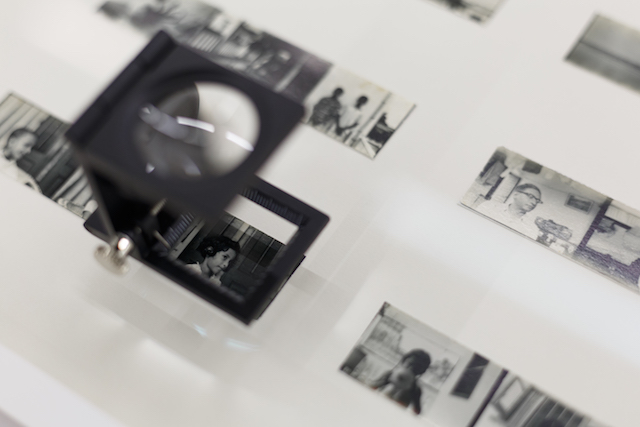
Naeem Mohaiemen at Experimenter, Kolkata, through 5 November
The post-partition histories of the subcontinent fictionalised by Rushdie find new tellers in Naeem Mohaiemen’s Volume Eleven (flaw in the algorithm of cosmopolitanism) at Experimenter, Kolkata. The show takes for a starting point a series of essays by the influential Bengali writer Syed Mujtaba Ali which, written between the world wars, predicted that Germany would defeat Britain and hasten India’s independence. Mohaiemen riffs on freedom and division by combining typewritten pages, photographs taken by the artist’s father during the 1950s, a video responding to those photographs and a transcribed conversation between the artist, his father and two aunts. Together they tell the stories of a family scattered across the world by the violent consequences of a society’s failure to accommodate different ways of seeing the world.

Micro Era. Media Art from China at Kulturforum, Berlin, through 26 January 2020
How artists can respond to social change is one subject of Micro Era. Media Art from China at Berlin’s Kulturforum, which features moving-image artists Cao Fei, Lu Yang, Fang Di and Zhang Peili in a follow-up to 2001’s living in time. 29 contemporary artists from China. The narrative that this exhibition seeks to challenge seems by comparison to the above examples a little academic: video art’s reputation, ‘within the Euro-American context’, as a democratising artform. Yet by interrogating the presumption that the free circulation of information is necessarily empowering to the majority, it might be hoped the show draws attention to how unevenly distributed access to technology is shaping the way that ‘truth’ is being manufactured and disseminated.

RIFTS: Thai contemporary artistic practices in transition at Bangkok Art and Culture Centre, through 24 November
At Bangkok Art and Culture Centre, meanwhile, RIFTS: Thai contemporary artistic practices in transition documents a comparably dramatic shift in the country’s production of contemporary art from the late 1980s onwards. Those changes were effected through new infrastructures as much as new media or subject matters, with artists establishing independent spaces and transnational networks; that new connections fragment old unities is reflected in the ambivalent title. Nevertheless, the exhibition features many of the biggest stars among the artists who emerged onto the national and international stage during the 1990s and 2000s, among them Araya Rasdjarmrearnsook, Chatchai Puipia, Chumpon Apisuk, Kamin Lertchaiprasert, Kamol Phaosavasdi, Manit Sriwanichpoom, Michael Shaowanasai, Montien Boonma, Navin Rawanchaikul, Pinaree Sanpitak, Prasong Luemuang, Rirkrit Tiravanija and Tawatchai Puntusawasdi: a generation that continues to exert a huge influence on the kingdom’s artists today.
Part II of ArtReview Asia’s autumn previews to follow…
From the Autumn 2019 issue of ArtReview Asia
